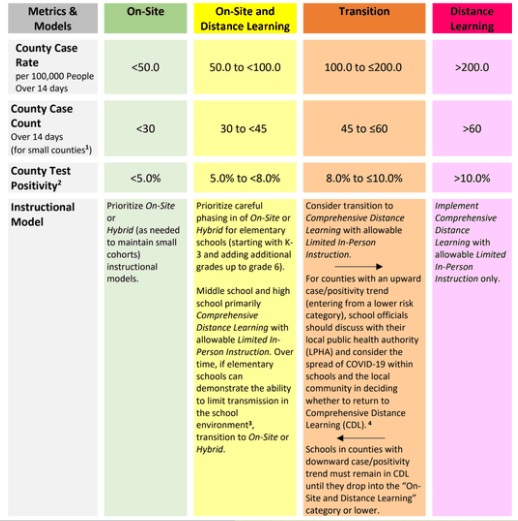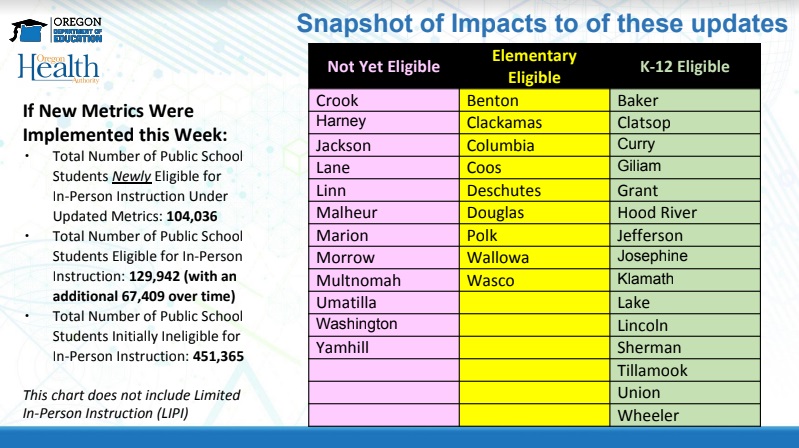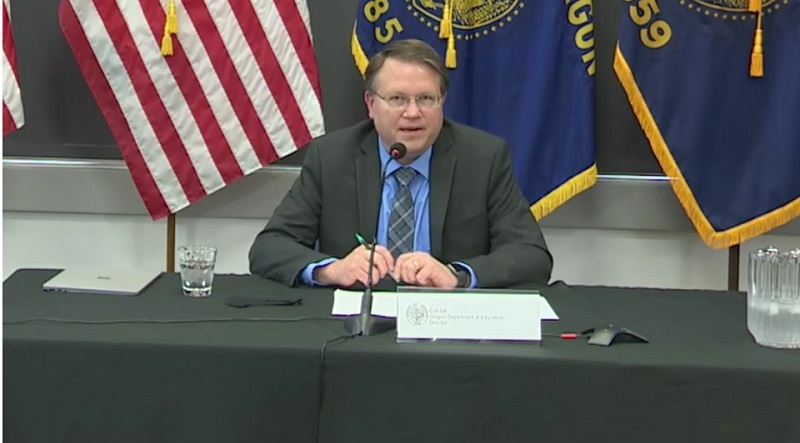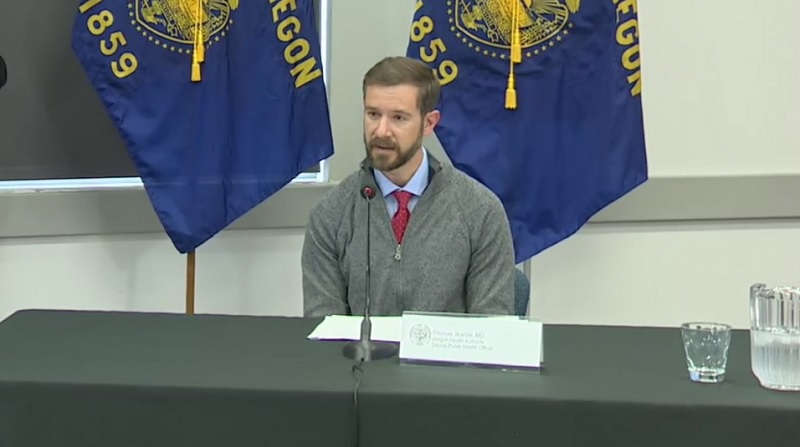PORTLAND, Ore. (KOIN) — Oregon Governor Kate Brown announced updated school COVID-19 guidelines in a press conference on Friday, one day after the state hit its highest daily coronavirus case count since the start of the pandemic.
Governor Brown was joined by representatives from the Oregon Health Authority and Oregon Department of Education at the 11 a.m. presser. Right off the bat, Brown dove into the statewide school coronavirus response and announced the ODE released updated metrics for returning to in-person instruction.
Per the Oregon Department of Education, the key points of the updated guidelines are:

- A clear set of reachable targets for communities to strive for, with a North Star of returning Oregon students to in-person instruction
- Acknowledgment that Oregon’s Ready Schools, Safe Learners guidance’s strong public health protocols in structured settings like schools can greatly reduce the risk of transmission of COVID-19
- Additional time for schools to transition between in-person and distance learning models
- Increased access to in-person instruction at the elementary level
- A two week “Look Back” at the metrics data rather than one week at a time over a three-week period
- Removes State Positivity Rate in favor of county positivity rates
The full outline of the updated guidelines can be found lower in this article
“My top priority has been and will always be the health and safety of Oregonians,” Brown said. “When we temporarily closed Oregon schools, we knew it was going to be an incredible interruption in each student’s education.”
Brown said throughout the last eight months, we have all learned more from our scientists and doctors — who have told her a zero-risk approach is not the way forward.

“We can be smart about minimizing risk while living our lives as safely as possible,” she continued. “Our updated metrics are based on the latest COVID-19 studies and data in line with CDC recommendations and bring Oregon in sync with other states like California. They also help us meet our priority of returning students to in-person instruction.”
Brown said it has become clearer in recent months that schools are not super spreader events.
However, while these new guidelines are more relaxed and will allow for more students to return to school, counties with high infection rates — such as Multnomah County — will still need to wait for numbers to decrease.
Furthermore, schools will need time to plan their return. This is not a change that will happen overnight or even within a few weeks.

OED Director Colt Gill followed Gov. Brown, saying these measures offer an intentional and measured approach to returning students to in-person learning, all while recognizing the importance of meeting the academic needs of each child. These new guidelines allow for in-person instruction in places of the state where the COVID-19 risk is lower than others.
“They also set a North Star for the rest of the state to work toward,” Gill said. “We all know that in-person instruction provides our children and families with more than access to an equitable education. Schools are a center of services to students and families, offering nutritious meals, access to social-emotional and mental health supports, as well as physical health services.”
Oregon Health Authority Deputy State Health Officer and Epidemiologist Dr. Thomas Jeanne spoke at the press conference as well, describing the new rules in-depth.
“The updates to our school metrics balance two priorities: more opportunities for in-person instruction when the risk is low & protecting the broader community from COVID-19,” Jeanne said. “While cases are rising – this week we reported two consecutive days of record high daily case counts including 600 today – we know the virus isn’t spreading as fast in every community and many counties have lower rates of positive COVID-19 tests than the state average.”

He said these updated reopening metrics are still among the most protective in the country — but are now more aligned with other states.
“They take into account the measures the CDC has recommended as benchmarks for school reopening, including case rates and test positivity thresholds over 14 days, risk mitigation strategies, and levels of transmission risk across different models of learning,” Jeanne explained. “It also draws on our increasing awareness that kids have not been a major driver of outbreaks, even in in-person learning settings that have been open. We landed on three major changes that will better align our metrics with neighboring states and evidence-based practices.”
He listed the three major changes as follows:
1. Removing the statewide 5% threshold for the percentage of tests coming back positive. They believe that this simpler approach will better reflect local conditions and the county test positivity will remain an important local metric.
2. Review period for examining metrics data changed from three consecutive one-week periods to a two-week period. This will avoid situations in which a one-time cluster in a smaller county essentially resets the clock.
3. Expanding the K-3 exception to elementary schools, up to the 6th grade.
“At the time of the original metric, evidence suggested kids of K–3 ages might be at a lower risk for transmitting COVID-19, but newer evidence suggests this may not be the case,” Jeanne said. “However, younger children still appear to have less severe illness than older children and adults.”
When asked about concern for teachers, faculty and other staff members at schools, Gill responded with the various measures that will be in place to protect people.
“We have protocols in place to reduce the risk of spread in a structured setting like a school.”
He said teachers will be working with a limited number of students and everyone entering the buildings — including each student — will be screened for symptoms at the door.
“We know there are many staff who are older and have medical conditions that certainly put them at higher risk for serve outcomes,” Jeanne chimed in. “We also know these basic preventive measures and the rigorous public health and safety measures public schools are implemented really do work well.”
Ready Schools, Safe Learners 2020-21 Guidance
Health officials reported 575 new cases of COVID-19 in Oregon on Thursday, the highest daily case count in the state since the start of the pandemic.
The new confirmed and presumptive cases are in the following counties: Baker (7), Benton (15), Clackamas (62), Clatsop (2), Columbia (1), Coos (2), Crook (1), Deschutes (25), Douglas (4), Grant (1), Harney (1), Hood River (5), Jackson (54), Jefferson (2), Josephine (1), Klamath (1), Lake (2), Lane (17), Linn (18), Malheur (7), Marion (62), Morrow (5), Multnomah (102), Polk (7), Sherman (1), Tillamook (2), Umatilla (42), Union (7), Wallowa (3), Washington (107) and Yamhill (9).
Oregon’s coronavirus death toll is now at 673.
The daily case count record was previously set one week ago when health officials reported 550 new cases in Oregon. The governor then decided to place Multnomah County back on her COVID Watch List.
Of those cases 550 cases last Friday, 135 were reported in Multnomah County. Oregon Health Authority’s Senior Health Advisory Dr. Shimi Sharief said trends that contribute to the higher case count in Multnomah County also play out across the state, namely, get-togethers with people outside the immediate household.
“Actually, it’s not that different from the rest of the counties, it’s just that certain trends can be noted to Multnomah County before we see it elsewhere—increased risk for crowding, just with more people living in a smaller amount of space,” said Sharief. “So, it’s actually the same reasons why Multnomah County is experiencing more cases than the rest of the counties in Oregon. It’s all just smaller gatherings, non-household gatherings, people clustering together in groups greater than their household.”
She said that while the state is still concerned about the potential for large outbreaks, what’s most concerning is the day-to-day, week-to-week increase of small clusters of sporadic cases.
“There’s at least 50% or more of each case that’s reported each day, ends up being in sporadic case counts,” said Sharief.
Based on current OHA models, if the trend continues, hospitals could reach capacity by mid-to-late December—another reason why officials say people shouldn’t let their guards down.
Also last week, the OHA revised its face-covering guidance to require people to wear face coverings “in all private and public workplaces including classrooms, offices, meeting rooms, and workspaces unless someone is alone in an office or in a private workspace.”
Face coverings are also now required in indoor and outdoor markets, street fairs, private career schools, and public and private colleges and universities.
OHA also said face coverings are better than face shields, except for those instances when, for instance, someone who is deaf or hearing impaired needs to read lips.
And the standard guidance remains: Stay 6 feet or more away, avoid large gatherings, limit social gatherings and wash your hands frequently.
Continuing Coverage: Coronavirus